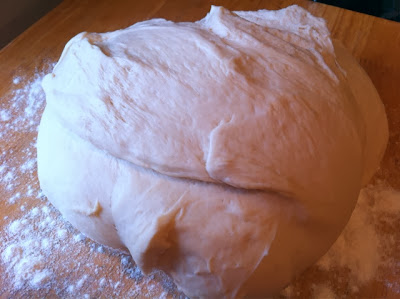My husband and I have a wonderful tradition: we
visit bakeries on trips, and we buy bread to bring home with us. The tradition
began in New York City, the magical place where we fell in love. On that fateful trip, we discovered Russ and Daughters, a Jewish deli where
we bought a dozen bagels to put in our freezer.
We found Orwashers, a bakery
on the Upper East Side that has been baking bread for almost 100 years. Our last stop was more intentional; it was Sullivan Street Bakery. I had wanted to visit Jim Lahey’s shop for a
couple of years, ever since I had begun baking his breads and pizzas. His book had been a big inspiration for me
since it changed the way I thought about home baking. His Dutch-oven method had enabled me to make bakery-quality
bread in my apartment, despite having a finicky electric oven. I was in love. Being in his bakery solidified that.
Baking pizza is a big passion of mine. I have played with many different styles of
pizza, and every time I go back to Jim Lahey’s original pizza method. He has since come out with a second book, My Pizza where he changed his recipe and
methods; both are great, but I have realized I am definitely a pan girl.
Fast forward to last summer when we spent a month in
Rome. Before we left on our trip I was
reminded by one of my father-in-laws that Jim Lahey did his apprenticeship at a
bakery in Rome. I was excited to go
where it all began.
It surprised me that a city as large as Rome would
have a unique baking style. It’s not like in New York where there are bakeries
from many different ethnicities. Another
big difference in a Roman bakery is that their pastry shops are separate. Italian bakeries will have some sweet things,
but they will be more subtle. For
example they may have a few types of cookies on display. The serious sweets are found in the
patisseries.
Every bakery in Rome had loaves of bread, some
rolls, and in the front of the stores are long, rectangular slabs of pizza and thick
cut focaccia bread. Some had layers of
mushrooms, while others were studded with green olives, and plump, roasted
tomatoes. There was always one type with
just cheese and thick tomato sauce oozing out over the edges. Once I saw the Roman bakeries, I understood
where Jim found his inspiration for his
bakery; it felt like coming full circle.
I knew I would go home and expand my repertoire.
One of Jim’s pizzas is called Pizza Patate; I had
always wanted to make it. Last weekend
we had a fall party and we remembered the recipe for Pizza Patate. We had some Yukon Gold potatoes on hand, and
we almost always do our own breads for parties. The pizza is baked in an oiled half-sheet pan,
and it has a wonderful texture that is both chewy and crunchy. The thinly sliced potatoes are the perfect
ratio to the dough, and the rosemary and onion are nice complements to the big
picture. We had many items on our spread
at the party, but the Pizza Patate stole the show.
Adapted from Jim Lahey
Dough
Ingredients:
1 1/3 cups or 300 grams room temperature water
2 ½ teaspoons or 10 grams active dry yeast
3 ¾ cups or 500 grams bread flour
1 1/3 teaspoons or 8 grams kosher salt
High heat cooking oil, such as grapeseed or avocado,
for the 13x18 half-sheet pan
Topping
Ingredients:
1 quart or 800 grams lukewarm water
4 teaspoons or 24 grams sea salt
6-8 or 1 kilo Yukon Gold potatoes (we used part red
French fingerlings, and that turned out to be a pretty color contrast)
1/3 cup cooking oil
1 cup or 100 grams diced yellow onion
½ teaspoon or 2 grams freshly ground black pepper
1 sprig fresh rosemary
The potatoes for this can be prepped up to a day
ahead, but you could also prep them while your dough is rising. For the potatoes: Slice them thinly on a mandolin
or about 1/16th of an inch by hand with a very sharp knife. Soak them in the salt and water for at least
1 hour. Before you are going to top the
pizza, dry the potatoes well on paper towels.
Mix the potatoes with the oil, salt, pepper, and onion.
Allow two hours for the dough. Mix together the ingredients for about 30
seconds. Try and stir going the same
direction in the bowl in an effort to not break up the developing gluten
strands. If the dough is not coming
together because it appears dry, hydrate the dough a tablespoon at a time. When the dough is fully hydrated and mixed,
cover the bowl with saran or a flour sack towel for 1 ½ hours.
Preheat the oven to 500 degrees. Lightly flour a prep surface. Using a bowl scraper, turn the dough out onto
the counter. Flour your hands as needed,
and working your way around the dough, form into a ball. Flour the top of the dough and cover for 30
minutes.
Using a pastry brush, oil the pan, including the
sides. Turn the dough, flour side down,
onto the pan. Gently nudge the dough
into the pan, stretching it evenly throughout.
Spread the potatoes over the surface of the dough, coming all the way to
the edges. You can put more potato
around the periphery since the edges cook faster than the middle. Scatter the rosemary over the top. Bake for 30-35 minutes.
Let the pizza cool a bit before cutting into
it. I used a sharp serrated blade in
lieu of a pizza cutter for this pizza, and I took my time cutting, so I didn't disturb the topping too much. Good luck!
This is a recipe that does well with slow and steady, and also your guests are
going to love you.




















































